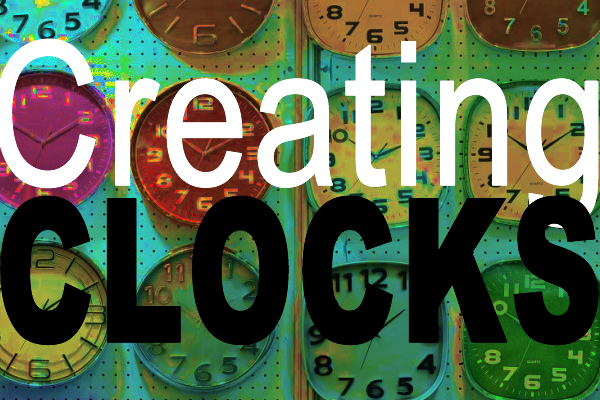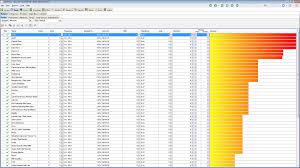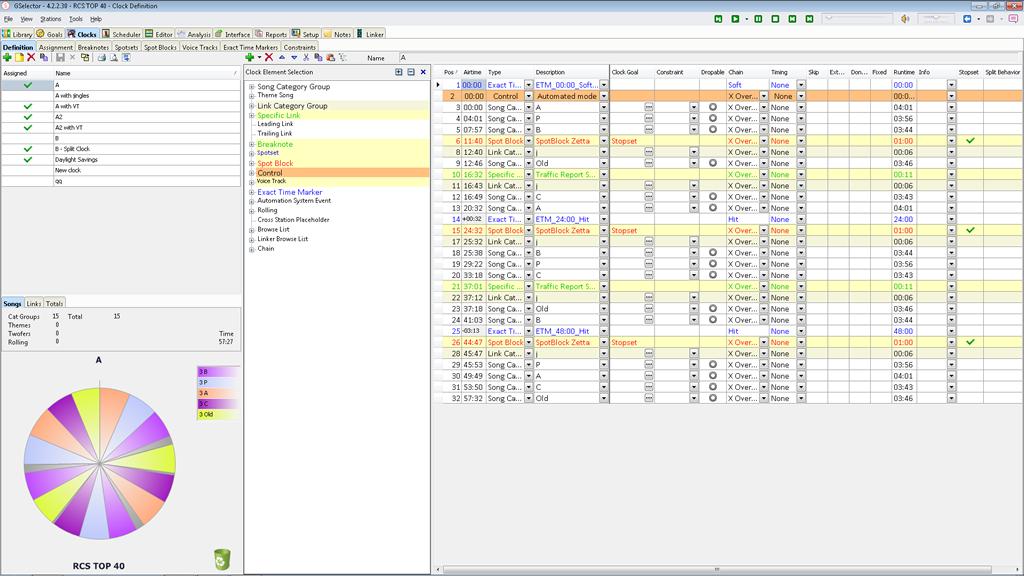Creating Clocks: The Lost Art Part 3

Creating perfect music clocks for your radio station is an art form. It combines strategy, tactics & creativity. It shouldn’t be rushed. It’s part of the blueprint in building a great radio station.
In some stations, creating clocks is becoming a lost art. I’ve attended many strategy meetings where clock creation is the last item on the agenda. I’ve asked some prominent programmers to share their views on crafting great clocks. Early I spoke to U.S. Programmer Todd Wallace. and Eriks Celmins, next some Words of Wisdom from Guy Zapoleon and Kaizen Media’s Dan Bradley.
 Words of Wisdom from the Brilliant Guy Zapoleon
Words of Wisdom from the Brilliant Guy Zapoleon
Music Clocks are constructed using a “Spoke Theory“, that is every other song should be massively popular, not only with your core, but also with your potential core audience.
Song 1= Killer Core+ Killer Cume
Song 2 =Killer Core + Cume Friendly
Song 3= Killer Core+ Killer Cume
Song 4 =Killer Core + Cume Friendly
Means for your cumers that if they don’t hear one song they love they are guaranteed to hear one the next song…and the core always hears “killers”. This develops a powerful expectation in your listener that keeps them tuning back in.
In this system, the Power Currents, Power Recurrents and Power Gold should all be created from this formula to maintain tune-in from other formats.
Managing Director of Kaizen Media, Dan Bradley shares his philosophy on clock building.
Building clocks is a combination of art and science, both play an important role in the process. Too much ‘science’ in the clock creation and execution of the universe management and there is the potential for a station to sound a little clinical (musically); too much ‘art’ and it can end up being a mess.
I’ve been guilty at times over the years of both. However, when you achieve the right balance the clocks do a lot of the ‘heavy lifting’ to manage the universe effectively.
I don’t have afavouriteclock as such, but I do have some principles that I believe are important to build and leverage the clock structure.
Universe Management
 Any clock in itself is only as good as the content of the categories. A primary category (gold or current) is called ‘primary’ for a reason; a secondary, or image, category is called that and placed in the clocks as that for a reason. Obvious, but lack of discipline in category development and management will weaken the music on any station.
Any clock in itself is only as good as the content of the categories. A primary category (gold or current) is called ‘primary’ for a reason; a secondary, or image, category is called that and placed in the clocks as that for a reason. Obvious, but lack of discipline in category development and management will weaken the music on any station.
The great stations (from a musical perspective), have many things in place – however a consistent theme is an absolute discipline in universe management.
As an example; one flaw is to be ‘tolerant’ of songs as they move through the current playlist to the recurrent stage. Maybe a song was a B, and got close but didn’t quite make an A? It goes straight to Recurrent. A song that perhaps was a ‘moment’ song (like aPsytype song a few years ago) goes through to recurrent/primary gold. A song made it to the A rotation, but the research fell away (wings-delta), and it moves through to Recurrent.
Whilst there are exceptions to every rule, when this ‘tolerance’ becomes a way of operating it is a slippery slope. The Recurrents are to some extent the most dangerous category on a station if not managed with real discipline. And for any clock grid to be effective and perform its role, the overall playlist/universe has to be managed with that same discipline.
Clock Design
When constructing an essence clock, the old ’20-minute’ test stands the test of time. And all the core criteria below fall under the umbrella of delivering on the 20-minute test;
Balance
Whatever you play, balance of eras, genres, and primary/secondary is important; through the hour, from hour to hour, between eras, within eras (i.e.: not 3 X 80s songs all from 1988 in the hour).
The great clocks are balanced and structured to achieve this (the science), and the human execution (the art) finesses it so it lives and breathes and works beautifully.
Protection roles
Primary songs are generally regarded as ‘protectors’ of the secondaries. The theory being from a listener’s perspective they’re always no more than 1 song away from a killer, I’ve generally aimed to protect secondary/image tracks with 2 primaries on either side. And this often works well. But there are exceptions; feature hours, feature weekends, where sometimes from a tactical perspective playing more secondaries makes sense – if it’s contexted for the listener and there is a reason for it that makes sense, then playing a touch more secondaries can be appropriate.
It is true that generally a tighter universe results in higher ratings, ‘more killers/more hit factor’, however I do believe that for the long-term ensuring that (depending on the format) listeners hear a well put together mix of the traditional ‘big testers’ and some ‘depth tracks’ makes good sense (with more big testers than depth clearly).
Variety at the ‘headlight points’
Headlight points are those points in an hour where a listener may be more likely to notice patterns. For example; vary the era of the first song out of the news, make sure that a ‘new’ song isn’t called after a speedy at song 3 in each hour, making sure a once an hour 80s flashback is varied in placement through the hour.
Varying the eras/songs called at headlight points is pretty easy to do; multiple clocks, rotating clock grids, staggered clocks M-F so not the same one in each hour….it isn’t hard, but you’d be surprised how often it is overlooked.
Science vs Art
By nature of putting an essence structure in place, perhaps some of this seems quite rigid, and certainly discipline is an absolutely critical trait in putting strong clocks in place and ensuring they work for the station and the listener. Without this discipline, the station musically risks being in a mess.
However, the best clock structure in the world, the best clocks in the world, will mean nothing without the ‘human’ element of scheduling them and executing them.
There has to be a ‘human feel’ to them, the clock is a guide that the great music executor will use as a roadmap and they’ll then juggle tracks for flow or feel, maybe drop in a different version of a song, the form guide will always be juggled tomaximisethe flow and feel, there are a hundred things to consider and a ‘set and forget’ approach is a guarantee of a boring station musically.
A disciplined approach to building essence clocks and to managing the universe/playlist is a common theme amongst good radio stations.
But a common theme amongst great stations (musically) is that they have the ability to balance the ‘science’ with the ‘art’ and really ‘feel’ the music on a station.
Dan Bradley is Executive Director of Kaizen Media; a boutique international radio consulting and artist management company, working with radio stations, media talent and music artists.
You can contact Dan here.


